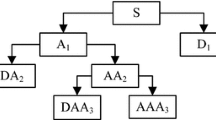Abstract
Electrocardiogram (ECG) indicates the occurrence of various cardiac diseases, and the accurate classification of ECG signals is important for the automatic diagnosis of arrhythmia. This paper presents a novel classification method based on multiple features by combining waveform morphology and frequency domain statistical analysis, which offer improved classification accuracy and minimise the time spent for classifying signals. A wavelet packet is used to decompose a denoised ECG signal, and the singular value, maximum value, and standard deviation of the decomposed wavelet packet coefficients are calculated to obtain the frequency domain feature space. The slope threshold method is applied to detect R peak and calculate RR intervals, and the first two RR intervals are extracted as time-domain features. The fusion feature space is composed of time and frequency domain features. A combination of support vector machine (SVM) with the help of grid search and waveform morphological analysis is applied to complete nine types of ECG signal classification. Computer simulations show that the accuracy of the proposed algorithm on multiple types of arrhythmia databases can reach 96.67%.
Graphical abstract








Similar content being viewed by others
Data availability
The datasets generated during and/or analysed during the current study are available from the corresponding author on reasonable request.
References
Benjamin EJ, Muntner P, Alonso A et al (2019) Heart disease and stroke statistics-2019 update: A report from the American Heart Association. Circulation 139:56–66
Angelantonio ED, Kaptoge S, Pennells L et al (2019) World Health Organization cardiovascular disease risk charts: revised models to estimate risk in 21 global regions. Lancet Global Health 7:1332–1345
Herry CL, Frasch M, Seely AJE, Wu HT (2017) Heart beat classification from single-lead ECG using the synchrosqueezing transform. Physiol Meas 38:171–187
Lenis G, Pilia N, Oesterlein T et al (2016) P wave detection and delineation in the ECG based on the phase free stationary wavelet transform and using intracardiac atrial electrograms as reference. Biomed Eng-Biomed Te 61:37–56
Karimipour A, Homaeinezhad MR (2014) Real-time electrocardiogram P-QRS-T detection-delineation algorithm based on quality-supported analysis of characteristic templates. Comput Biol Med 52:153–165
Sahoo S, Kanungo B, Suresh B, Sabut S (2017) Multiresolution wavelet transform based feature extraction and ECG classification to detect cardiac abnormalities. Measurement 108:55–66
Li H, Wang X, Chen L, Li E (2014) Denoising and R-peak detection of electrocardiogram signal based on EMD and improved approximate envelope. Circ Syst Signal Pr 33:1261–1276
Sudarshan VK, Acharya UR, Oh SL et al (2017) Automated diagnosis of congestive heart failure using dual tree complex wavelet transform and statistical features extracted from 2 s of ECG signals. Comput Biol Med 83:48–58
Guler I, Ubeyli ED (2005) ECG beat classifier designed by combined neural network model. Pattern Recogn 38:199–208
Liu N., Sun M., Wang L., et al.: A support vector machine approach for AF classification from a short single-lead ECG recording. Physiol. Meas. 39, 064004 (2018)
Zhu W, Chen X, Wang Y et al (2019) Arrhythmia recognition and classification using ECG morphology and segment feature analysis. IEEE ACM T Comput Bi 16:131–138
Dokur Z, Olmez T, Yazgan E (1999) Comparison of discrete wavelet and Fourier transforms for ECG beat classification. Electron Lett 35:1502–1504
Kumar A, Komaragiri R, Kumar M (2018) Heart rate monitoring and therapeutic devices: a wavelet transform based approach for the modeling and classification of congestive heart failure. ISA T 79:239–250
Ye C, Kumar BVKV, Coimbra MT (2012) Heartbeat classification using morphological and dynamic features of ECG signals. IEEE T Bio-med Eng 59:2930–2941
Ebrahimi Z., Loni M., Daneshtalab M., et al.: A review on deep learning methods for ECG arrhythmia classification. Expert Syst. Appl. 7, 100033 (2020)
Sharma P, Dinkar SK, Gupta DV (2021) A novel hybrid deep learning method with cuckoo search algorithm for classification of arrhythmia disease using ECG signals. Neural Comput & Applic 2:172–193
Chen S, Hua W, Li Z, Li J, Gao X (2017) Heartbeat classification using projected and dynamic features of ECG signal. Biomed Signal Proces 31:165–173
Sanamdikar S.T., Hamde S.T., Asutkar V.G.: Classification and analysis of cardiac arrhythmia based on incremental support vector regression on IOT platform. Biomed. Signal Proces. 64, 102324 (2021)
Zadeh A, Khazaee A (2011) High efficient system for automatic classification of the electrocardiogram beats. Ann Biomed Eng 39:996–1011
Lu L, Yan J, De SCW (2016) Feature selection for ECG signal processing using improved genetic algorithm and empirical mode decomposition. Measurement 94:372–381
Ramkumar M., Babu C.G., Priyanka G.S., et al.: Ecg arrhythmia signals classification using particle swarm optimization-support vector machines optimized with independent component analysis. IOP Conference Series: Materials Science and Engineering 1084(1), 012009 (2021)
Abdelhamid D, Latifa H, Naif A, Farid M (2012) A wavelet optimization approach for ECG signal classification. Biomed Signal Proces 7:342–349
Alan SSA, Omar AMA, Majd SM, Adel SE, Sabri S (2018) Features optimization for ECG signals classification. IJACSA 9:383–389
Li H, Wang X (2013) Detection of electrocardiogram characteristic points using lifting wavelet transform and Hilbert transform. T I Meas Control 35:574–582
Acknowledgements
Hongqiang Li acknowledges the support from the Tianjin Talent Special Support Program. Juan Daniel Prades García acknowledges the support from the Serra Hunter Program, the ICREA Academia Program, and the Tianjin Distinguished University Professor Program.
Funding
This work was supported by the Tianjin Key Research and Development Program (No. 19YFZCSY00180), the Tianjin Major Project for Civil-Military Integration of Science and Technology (No. 18ZXJMTG00260), the Tianjin Science and Technology Program (No. 20YDTPJC01380), and the Tianjin Municipal Special Foundation for Key Cultivation of China (No. XB202007).
Author information
Authors and Affiliations
Corresponding author
Ethics declarations
Conflict of interest
The authors declare no competing interests.
Additional information
Publisher's Note
Springer Nature remains neutral with regard to jurisdictional claims in published maps and institutional affiliations.
Rights and permissions
About this article
Cite this article
Li, H., An, Z., Zuo, S. et al. Classification of electrocardiogram signals with waveform morphological analysis and support vector machines. Med Biol Eng Comput 60, 109–119 (2022). https://doi.org/10.1007/s11517-021-02461-4
Received:
Accepted:
Published:
Issue Date:
DOI: https://doi.org/10.1007/s11517-021-02461-4




